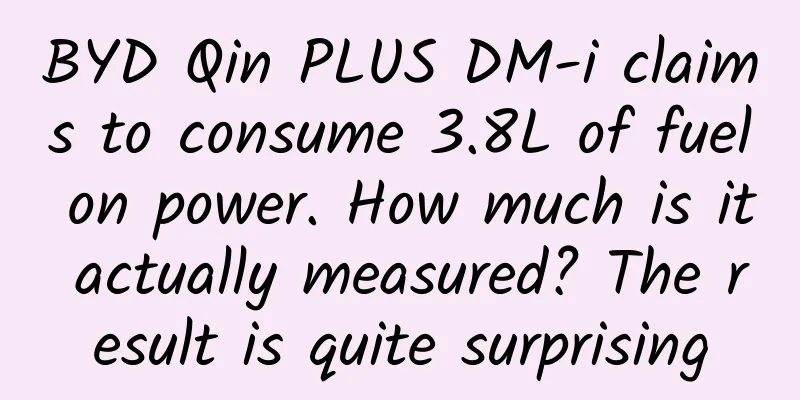BYD Qin PLUS DM-i claims to consume 3.8L of fuel on power. How much is it actually measured? The result is quite surprising

|
On the evening of January 11, BYD officially announced that the pre-sale of the new sedan Qin PLUS has officially started. There are four models in total, with a pre-sale price of 107,800-147,800 yuan. It will be officially launched in early March this year. The biggest highlight of the new car is the power part. It will be equipped with BYD's latest DM-i plug-in hybrid system, which consists of a 1.5L naturally aspirated engine + electric motor. Among them, the 1.5L high-efficiency engine dedicated to Xiaoyun-plug-in hybrid has an engine thermal efficiency of up to 43.03%. Officials said that even when the battery is low, it can still achieve a low fuel consumption of 3.8L/100km, while the Ministry of Industry and Information Technology's fuel consumption is only 0.7L/100km; the acceleration from 0 to 100km/h is only 7.3s, and the comprehensive cruising range can reach 1245km. So, how strong is the vehicle's actual fuel consumption? Some media have already conducted fuel consumption tests on it. The main purpose of the fuel consumption test is to simulate the actual fuel consumption performance of users in real usage scenarios with power supply without being plugged in. At the beginning of the test, the vehicle's battery SOC was 25% (i.e. only 25% of the battery power), and the energy feedback level was adjusted to the maximum. The driving mode was ECO, there were three people in the car, the air conditioner was 22℃, the second gear wind volume, and the outdoor temperature was 6, 7℃. The test vehicle was the Qin PLUS standard endurance version (pure electric range 55km version). At the beginning, the vehicle's fuel tank was full and it traveled a total of 108.4 km through Shenzhen Expressway, urban expressway, and congested sections of the city. As a result, the second time of refueling, the amount of fuel filled was 3.65L, which is equivalent to a comprehensive fuel consumption of 3.37L/100km, which is much lower than the official nominal fuel consumption of 3.8L/100km, which is quite amazing. In addition, the representatives of joint venture brand family cars, Sylphy and Lavida, also competed in the segment, achieving the best fuel consumption results of 4.68L/100km and 5.4L/100km respectively. In terms of acceleration performance, the BYD Qin PLUS DM-i standard range version can accelerate from 0 to 100 km/h in 7.9 seconds, while the long range version can accelerate from 0 to 100 km/h in 7.3 seconds. Compared with Toyota and Honda's hybrid models, BYD Qin PLUS has obvious advantages in fuel consumption and power. So, how did BYD do it? According to official introduction, in the DM-i super hybrid system, the drive motor undertakes most of the work and acceleration conditions, while the engine does the least and most fuel-efficient work. In pure electric mode, the high-energy DM-i super hybrid dedicated power blade battery is responsible for powering the drive motor. In most hybrid modes, the engine drives a high-power generator to supply power to the drive motor. In medium and high-speed driving conditions, the engine directly drives or drives the motor at the right time, and outputs power in parallel. In addition, in order to achieve lower fuel consumption, this 1.5L Xiaoyun plug-in hybrid engine has a compression ratio of up to 15.5, and the air-conditioning compressor, vacuum pump and other accessories are all changed to electric drive, engine split cooling, and reduced internal friction loss. As a result, the overall fuel consumption is further reduced. Overall, in terms of power, fuel consumption and even price configuration, BYD Qin PLUS has obvious advantages over joint venture models of the same level. Moreover, as a super plug-in hybrid model, Qin PLUS can also enjoy multiple benefits such as exclusive green license plates for new energy vehicles, promotion subsidies, exemption from purchase tax, etc. Compared with dual-engine hybrids such as Toyota Corolla and Honda Lingpai, its cost-effectiveness advantage is more obvious. It can be said that the arrival of BYD Qin PLUS DM-i has completely brought BYD's powertrain to the first-tier level in China and even the world. In the future, we will just have to wait and see what kind of results this car can achieve in the market. As a winner of Toutiao's Qingyun Plan and Baijiahao's Bai+ Plan, the 2019 Baidu Digital Author of the Year, the Baijiahao's Most Popular Author in the Technology Field, the 2019 Sogou Technology and Culture Author, and the 2021 Baijiahao Quarterly Influential Creator, he has won many awards, including the 2013 Sohu Best Industry Media Person, the 2015 China New Media Entrepreneurship Competition Beijing Third Place, the 2015 Guangmang Experience Award, the 2015 China New Media Entrepreneurship Competition Finals Third Place, and the 2018 Baidu Dynamic Annual Powerful Celebrity. |
<<: Making cars! For Baidu, this is a must-answer question that must get a high score
>>: Electric car value retention rate list: NIO ES6 and Tesla Model 3 exceed 70%
Recommend
Another mysterious "aliens" has visited Earth! It's visible to the naked eye!
Following Comet Neowise in 2020 and Comet Leonard...
Gaming on smartwatches: Break through or stop
Editor's note: I always think that making gam...
Analysis of Zhihu content operation and promotion strategy!
While the number of registered users of Zhihu has...
User Operation | How to do user behavior path analysis?
User behavior path analysis is a type of data ana...
I'm going to share 48 tricks to attract fans. If you don't have fans anymore, you can only blame yourself.
I'm going to share 48 tricks to attract traff...
Tik Tok Advertising Promotion | What is the billing method for Tik Tok advertising?
With the popularity of TikTok, many businesses wa...
Android 10 brings a new technology to detect whether there is liquid or overheating in the USB port of the mobile phone
Google officially released the Android 10 mobile ...
There are also "giant pandas" in the water, and they also "serve" as water quality "inspectors"
The peach blossom fish is transparent, headless a...
Confronting gender discrimination in academia: Too few female scientists will affect the health of all women
Eternal feminine, lead us upward. Das ewige weibl...
User operation: How to perform user segmentation reasonably?
User stratification is the result of business ope...
How to monetize short videos on Douyin? A comprehensive review of Douyin's methods of attracting fans and monetizing
Tik Tok is a very popular video platform nowadays...
How much does it cost to create a bargaining app in Hailar?
The factors that affect the quotation produced by...
Don't buy this kind of dried flowers for indoor decoration! It's illegal!
During the New Year, everyone likes to buy some N...
What is the stall spin mentioned repeatedly in "King of the Sky"? How to deal with it?
In the movie "Lord of the Skies", the t...
Refined user growth case!
ABtest is gaining more and more attention. Fast a...









